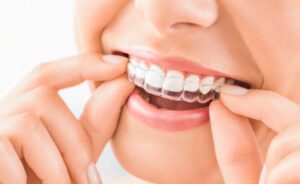
Invisalign has become one of the most popular orthodontic treatments in recent years, especially among teens and adults looking for a discreet way to straighten their teeth. While many people think of Invisalign as just a cosmetic fix, it actually offers more than just a straighter smile. One of the most common questions patients have is: Can Invisalign fix bite problems? The answer is yes, Invisalign can effectively treat many types of bite issues, depending on their complexity.
Let’s explore how Invisalign works and which bite problems it can correct.
What is a Bite Problem?
A “bite problem,” also known as a malocclusion, refers to the way your upper and lower teeth come together when your mouth is closed. Ideally, your bite should align evenly, but many people experience issues such as:
- Overbite – when the upper front teeth extend too far over the lower front teeth.
- Underbite – when the lower front teeth stick out beyond the upper front teeth.
- Crossbite – when some upper teeth sit inside the lower teeth instead of outside.
- Open bite – when the upper and lower teeth don’t touch when the mouth is closed.
- Deep bite – a more extreme form of overbite.
- Spacing and crowding – too much or too little space between teeth.
These issues can cause more than just cosmetic concerns; they may lead to difficulty chewing, jaw pain, uneven wear on teeth, and even speech problems.
How Invisalign Fixes Bite Issues
Invisalign uses a series of custom clear aligners made of smooth, flexible plastic. These aligners gradually shift your teeth into better alignment through controlled force. For bite problems, Invisalign works by moving not just the teeth but also adjusting how the upper and lower jaws relate to each other over time.
The treatment process begins with a digital scan and 3D treatment plan created by your dentist or orthodontist. Each set of aligners is worn for 1 to 2 weeks before switching to the next, and most people wear them for 20 to 22 hours a day.
In some cases, Invisalign treatment may also include:
- Attachments or buttons to assist with complex movements.
- Elastics to help adjust the bite.
- Interproximal reduction (IPR) to create space between crowded teeth.
Which Bite Problems Can Invisalign Correct?
Invisalign is effective at treating mild to moderate bite problems. For more complex cases, traditional braces or even surgical intervention may be recommended.
Conditions Invisalign can commonly treat include:
- Mild to moderate overbite or underbite.
- Crossbite involving just a few teeth.
- Mild open bite.
- Tooth crowding and spacing.
- Relapse from previous orthodontic treatment.
Is Invisalign Right for You?
The only way to know for sure is to schedule a consultation with your dentist or orthodontist. They’ll evaluate your bite, jaw alignment, and overall dental health to determine if Invisalign is a suitable option for your specific needs.
Invisalign is a powerful orthodontic solution that can correct many types of bite problems and improve your overall oral health. If you’re dealing with a bite issue and want a more comfortable, nearly invisible solution, Invisalign might be the answer you’ve been looking for.
About the Author
Dr. Natalya Ramsay is a graduate of the Oregon Health and Science University School of Dentistry. She stays current with the latest developments in the dental field with ongoing education courses in topics such as pediatric and cosmetic dentistry. Dr. Ramsay also does volunteer work as part of the Medical Teams International Dental Van, which provides mobile care for low-income patients in need, including serving the Yamhill community. If you’re interested in straightening out your smile with Invisalign clear aligners, Dr. Ramsay and our fun, friendly, and highly skilled team can make your dreams come true! Schedule your appointment with us today online or call us at (503) 472-1402.
